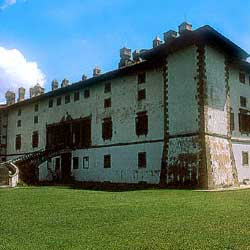|
 Prato
is the second-largest city in Tuscany and became the capital of a new
province in 1992, before which it had been part of the province of Firenze. Prato
is the second-largest city in Tuscany and became the capital of a new
province in 1992, before which it had been part of the province of Firenze.
The entrepreneur from Prato, Giuliano Gori, has turned his 18th
century Fattoria di Celle in the Pistoia area into a kind of art gallery.
Both the park and the interior of this splendid villa house works by great
modern artists, who stay at the villa and produce their work on site so
that they fit naturally into the context of the villa.
The local cuisine is traditional Tuscan, with the notable exception of
the famous cantucci di Prato, dry biscuits with large pieces of
almond inside that are excellent when dipped in Vin Santo, and the bozza
di Prato, a round bread loaf typical of the city.
The Valle del Bisenzio runs between the ridge of the Tuscan-Emilian
Appennines and the Calvana hills (visible from the Florentine plain of
the Arno), and joins the provinces of Prato and Pistoia on the boundary
of the central segment of the Tuscan-Emilian Appennines. The boundary
pass, 700m above sea level, is in an ideal position to cross from north
to south. Work started on the Firenze-Bologna railway in 1913, was interrupted
by the war, but was finished in 1934 after the completion of long sections
of tunnel which make up 45% of the entire route.
There's a great variety of scenery in this valley, ranging from
the bleak peaks of the Appennines to the hills and the plain. The first
settlements in the area date back to the Etruscans and Romans. In the
medieval period, the valley developed as a communications route through
to the Pianura Padana.
In the 1500s, the hilly areas of the valley were chosen by rich
Florentine families like the Medici and Bardi as the site for splendid
villa-estates, which had a positive knock-on effect on the agriculture
of the area. Finally, around about 1850, various industrial
activities began to spring up in the valley bottom, 'adding' to the
view with factories and chimney stacks.
The most important villages in the valley are Vaiano, Vernio, and Montepiano.
Picture by Sandro Santioli
Illustration by Olga Bruno
|